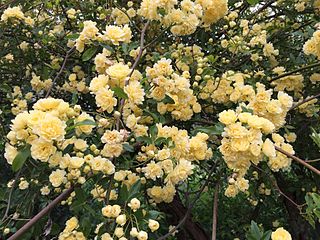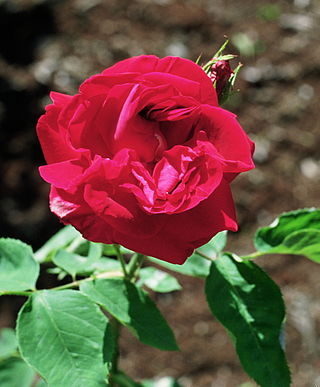
Rosa multiflora — is a species of rose known commonly as multiflora rose, baby rose, Japanese rose, many-flowered rose, seven-sisters rose, Eijitsu rose and rambler rose. It is native to eastern Asia, in China, Japan, and Korea. It should not be confused with Rosa rugosa, which is also known as "Japanese rose", or with polyantha roses which are garden cultivars derived from hybrids of R. multiflora. It was introduced to North America, where it is regarded as an invasive species.

Hibiscus syriacus is a species of flowering plant in the mallow family, Malvaceae. It is native to Korea, and south-central and southeast China, but widely introduced elsewhere, including much of Asia. It was given the epithet syriacus because it had been collected from gardens in Syria. Common names include the rose of Sharon,, Syrian ketmia, shrub althea, and rose mallow. It is the national flower of South Korea and is mentioned in the South Korean national anthem.

Dasiphora fruticosa is a species of hardy deciduous flowering shrub in the family Rosaceae, native to the cool temperate and subarctic regions of the northern hemisphere, often growing at high altitudes in mountains. Dasiphora fruticosa is still widely referenced in the horticultural literature under its synonym Potentilla fruticosa. Common names include shrubby cinquefoil, golden hardhack, bush cinquefoil, shrubby five-finger, widdy, and kuril tea.

Rosa 'Ispahan', also known as 'Rose d'Ispahan' and 'Pompon des Princes', is a clear pink, half-open kind of Damask rose, a type of garden rose introduced from the Middle East to Europe during the crusading 13th century.

Syringa vulgaris, the lilac or common lilac, is a species of flowering plant in the olive family Oleaceae, native to the Balkan Peninsula, where it grows on rocky hills. Grown for its scented flowers in spring, this large shrub or small tree is widely cultivated and has been naturalized in parts of Europe, Asia and North America. It is not regarded as an aggressive species. It is found in the wild in widely scattered sites, usually in the vicinity of past or present human habitations.

Wisteria floribunda, common name Japanese wisteria, is a species of flowering plant in the family Fabaceae, native to Japan. Growing to 9 m (30 ft), Wisteria floribunda is a woody, deciduous twining climber. It was first brought from Japan to the United States in the 1830s. Since then, it has become one of the most highly romanticized flowering garden plants. It is also a common subject for bonsai, along with Wisteria sinensis.

Rosa banksiae, common names Lady Banks' rose, or just Banks' rose, is a species of flowering plant in the rose family, native to central and western China, in the provinces of Gansu, Guizhou, Henan, Hubei, Jiangsu, Sichuan and Yunnan, at altitudes of 500–2,200 m (1,640–7,218 ft). The rose is named for Dorothea Lady Banks, the wife of the botanist Sir Joseph Banks.

Euonymus fortunei, the spindle, Fortune's spindle, winter creeper or wintercreeper, is a species of flowering plant in the family Celastraceae, native to east Asia, including China, Korea, the Philippines and Japan. It is named after the Scottish botanist and plant explorer Robert Fortune. E. fortunei is highly invasive and damaging in the United States, causing the death of trees and forest in urban areas.

Rosa 'Général Jacqueminot', also called 'General Jack' or 'Jack Rose', is an early Hybrid Perpetual rose cultivar, developed by Roussel, an amateur from Meudon, and introduced by the gardener Rousselet in 1853. The flower was named in honor of Jean-François Jacqueminot (1787-1865), a French general of the Napoleonic Wars. Its parentage is unclear, but 'Gloire des Rosomanes' and 'Géant des Batailles' are considered probable ancestors.

Viburnum plicatum is a species of flowering plant in the family Adoxaceae, native to mainland China, Korea, Japan, and Taiwan. The Latin specific epithet plicatum means “pleated”, referring to the texture of the leaves.

Rosa'Double Delight',, is a multiple award-winning, red blend hybrid tea rose cultivar bred in the United States by Swim & Ellis and introduced in 1977. Its parents were two hybrid tea cultivars, the red and yellow 'Granada' and the ivory 'Garden Party'.

Garden roses are predominantly hybrid roses that are grown as ornamental plants in private or public gardens. They are one of the most popular and widely cultivated groups of flowering plants, especially in temperate climates. An enormous number of garden cultivars have been produced, especially over the last two centuries, though roses have been known in the garden for millennia beforehand. While most garden roses are grown for their flowers, often in dedicated rose gardens, some are also valued for other reasons, such as having ornamental fruit, providing ground cover, or for hedging.

Rosa 'Nevada' is a white climbing rose cultivar developed by Pedro Dot in Spain in 1927. It is one of his most successful creations and is named for its colour, as nevada is the Spanish word for "snowy". Its parentage was long under discussion, as Dot introduced the cultivar as a hybrid moyesii, but the cultivar's round, black hips point to its R. pimpinellifolia-parentage. It is probably a cross between Dot's pink hybrid tea 'La Giralda' and the wild rose species Rosa pimpinellifolia var. altaica, but is sometimes still described as a hybrid moyesii.

Rosa 'Albéric Barbier' is a popular Hybrid wichurana rose cultivar that was bred in 1900 by Barbier Frères & Compagnie. Its parents were R. wichurana and the yellow hybrid tea 'Shirley Hibberd', named after the Victorian gardening writer (1825–1890).

Rosa 'Arthur Bell',, is a yellow rose cultivar, bred by Sam McGredy IV in Northern Ireland in 1964. The rose has won numerous awards, and is popular in England and Northern Europe.

Rosa 'Cécile Brünner', also known as 'Mlle Cécile Brünner', 'Sweetheart Rose', 'Malteser Rose', or 'Mignon', is a light pink polyantha rose bred in France by Marie Ducher and introduced by her son-in-law, Joseph Pernet-Ducher in 1881. Its parents were a double-flowered R. multiflora and a hybrid tea rose, either 'Souvenir d'un Ami' or a seedling of 'Mme de Tartas'. It is not clear if the rose was named after the sister (1853–1927) or daughter of Ulrich Brunner fils.

Rosa 'Perle d'Or' is an apricot blend Polyantha rose cultivar bred by Joseph Rambaux in 1875 and introduced by Francis Dubreuil in France in 1883. 'Perle d'Or' was granted several awards, including the Lyon Gold Medal in 1883, and the Royal Horticultural Society's Award of Garden Merit in 1993.

Rosa 'Blush Noisette' is a light pink Noisette rose introduced by Phillipe Noisette around 1815. It was one of the first Noisette roses, and over time has been called by a multitude of names, including Rosa × noisettiana, 'Rosier de Philippe Noisette', 'Noisette de l'Inde, 'Blush Cluster', or 'Noisette Carnée'. According to the RHS Encyclopedia of Roses, the cultivar is mostly called 'Blush Noisette' in America, and otherwise known as 'Noisette Carnée'. 'Blush Noisette' arose as a seedling from the light pink rose hybrid 'Champney's Pink Cluster', introduced by Champneys around 1811, and was the first frost-hardy climber flowering repeatedly, giving the cultivar importance as a parent rose.

Rosa 'Queen Elizabeth' is a pink Grandiflora rose cultivar, bred by rose grower, Dr. Walter Lammerts in the United States in 1954. The rose variety is very popular worldwide and has won numerous awards, including "World's Favorite Rose", (1979).

Rosa 'Primevère' is a yellow hybrid wichurana, a large-flowered climbing rose. The cultivar was bred by French rose breeder, René Barbier in 1929. It is thought to be the best yellow large-flowered Wichurana rambler.




















